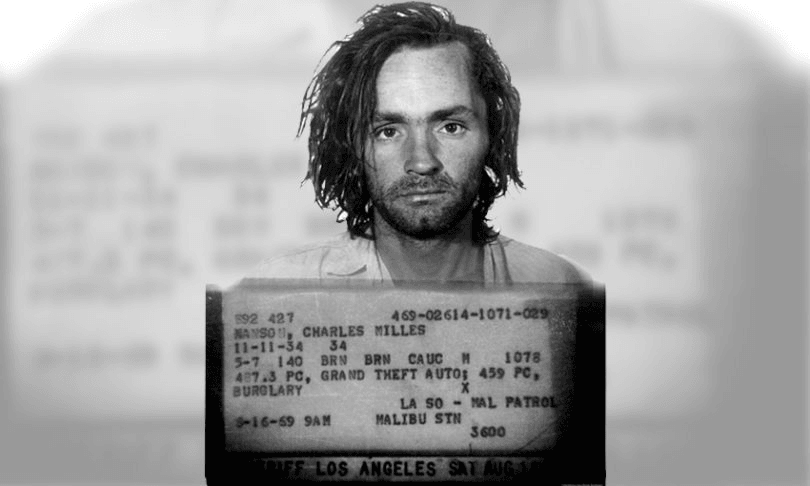Jean Sergent reviews Prime TV’s Manson: The Lost Tapes, a documentary that looks inside the Manson Family and sheds light on the darkest ‘family’ in recent American history.
It’s going to be a glut season for Manson Family content, with the 50th anniversary of the Tate Labianca murders in early August. Tom O’Neil’s new book Chaos, and Quentin Tarantino’s Once Upon A Time in Hollywood are two such crops of the semicentenary harvest. If Charles Manson and his followers is a true crime story you get something out of then, well, Merry Christmas I guess.
The two-part documentary Manson: The Lost Tapes provides something new and fascinating – quite an achievement for a story that has become so entrenched in the cultural history of the 20th century. Even if you don’t know the whole story, you definitely know the gist.
Gist-knowledge or nay, here’s a precis of the facts: Charles Manson was a psychopath who lured young people to live with him on a ranch in California. He serially poisoned them with LSD to make them suggestible, and subjected them to psychological torture. He then induced in them such a sense of violent rage that six of his followers murdered seven people over the course of two nights. For posterity, and clarity: the victims were Sharon Tate, Jay Sebring, Abigail Folger, Wojciech Frykowski, Steven Parent, Leno Labianca, and Rosemary Labianca.
Manson: The Lost Tapes uses archive footage taken at Spahn Ranch – the home of “the family” – after the arrests of Manson and the murderers. The footage is sad and frightening for one main reason: all these hippies with guns are so damn young.
Three girls with identical haircuts open the documentary, calmly spouting violent rhetoric about needing to defend themselves: “If we were unarmed we would chew their necks off,” one says. They look like they couldn’t be more than 16 years old. It’s one thing to know, intellectually, that some of the people in “the family” were very young runaways, but to actually see it is sickening.
The archival footage is melded with voiceover narration and new interviews with some of the former members of the family. The voiceover lands a bit oddly at first because, despite it being such an American story, it’s narrated by beloved English actress Zoë Wanamaker (Madame Hooch in Harry Potter, lately of Killing Eve).
The new interviews provide more fascinating insights, and help to contextualise some aspects of the story that with the benefit of hindsight seem unfathomable. “There were some happy times,” says Catherine Share. “We had some happy times in the desert.” Share was born to French Resistance fighters, and survived the Holocaust. She was older than the other girls at Spahn Ranch, but no less able to be influenced.
While she didn’t take part in the murders, she carved an X into her forehead in solidarity with her leader. Her reflections now on being part of the family do much to explain why somebody would be drawn to Manson: family isolation, a history of trauma at a young age, and feeling like the world wasn’t made for you.
The documentary’s interviews with men, both in the archival footage and in the new supplementary footage, are wildly different in tone and content from the interviews with women. The structure of “the family” was clearly far from a new hippy world order, but rather reinforced rigid gender norms, particularly when it came to sex and sexuality.
Whereas the young women in the cult came from difficult and traumatic backgrounds, the men were there mainly to play guitars, take drugs, and have sex without consequences, all while doing very little work. “There was a big puff of marijuana smoke and that smelled pretty good to me,” is a very different statement to “I felt (Charlie) was a pretty sadistic kind of a character. He bit people. He was cold and cruel and selfish.” Guess which was said by a woman.
And, of course, there were children born at the ranch; and, of course, those children were neglected by the men and barely taken care of by the women.
Charles Manson himself is largely absent from The Lost Tapes, although the documentary – like the lives of his followers – revolves entirely around his influence. When he does appear in news media archival footage, he is the epitome of the American Psychopath, both snarling and grinning, happy to be noticed, proud of what he has done, eager for more shock and attention. The details of the murders and the murder scenes are shocking and awful and deeply disturbing; the fact that “Charlie” wasn’t there when they happened has little to do with his immense culpability.
This is a disturbing and fascinating documentary which has appeal for true crime buffs as well as Manson completists. It’s a stunning piece of filmmaking that leaves the viewer unsettled and angry. The Lost Tapes is standout of the Manson Industrial Complex, because it doesn’t trade on sexiness or gore. It’s just deeply sad.
Manson: The Lost Tapes airs in two parts on Prime, starting this Sunday at 9:30pm.
